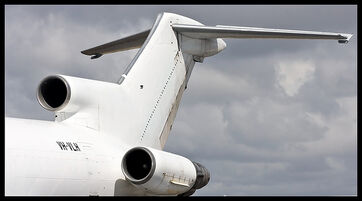
The "T" tail of a Boeing 727.
The "T" tail is an aircraft tail configuration which consists of having the airplanes horizontal stabilizer fixed atop of its vertical one. It's name is derived from the letter "T" shape which it forms.
Design[]
In commercial aircraft, this type of tail configuration is often seen on planes with their engines located in the rear of the body, (on the fuselage) instead of under the wings.
Advantages[]
- Allows the horizontal tail surfaces to remain clear of jet exhaust and turbulent trailing edge downstream air.
- Increased Spin recovery.
Disadvantages[]
- Due to the elevators' height, they're more difficult to reach during routine maintenance.
- Increased risk of pitch up.
- Increased risk of a Deep Stall, and decreased stall recovery.
Edited by Jon Fama July 19, 2021 6:15 AM EST
Aircraft[]
Commercial planes[]
- BAC One Eleven
- BAE-146
- Boeing 717
- Boeing 727
- Douglas DC-9
- Hawker Siddley Trident
- McDonnell Douglas MD-80
- Tupolev TU-154
- Yakovlev YAK-40
- Yakovlev YAK-42
Regional airliners[]
- ATR-42
- ATR-72
- Britten Norman Trislander
- DHC-7
- DHC-8
- Embraer 120
- Embraer 145
Cargo planes[]
- Illyushin IL-76
Business jets[]
- Cessna Citation X]]
- Learjet 25
- Learjet 35
- Learjet 45
Military aircraft[]
- F-101 Voodoo
- C-141 Starlifter
- C-5 Galaxy
- C-17 Globemaster III
Helicopters[]
- Boeing Sikorsky RAH-66 Comanche
Trivia[]
- The Boeing 727 is the only major trijet to have this configuration; however, Russian manufacturers Tupolev and Yakovlev continued the design in some of their aircraft, though they didn't become that popular in the rest of the world.
- The Britten Norman Trislander is the only aircraft of this type to have three propellers; the tail one is in the top of the vertical stabilizer.